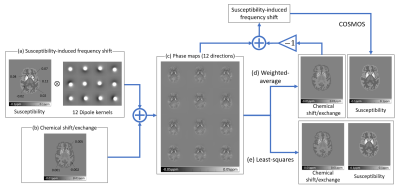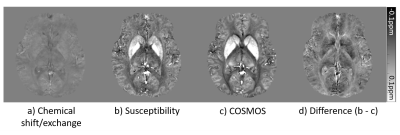3225
Generalized methods for separating susceptibility and chemical shift/exchange1Department of Electrical and Computer Engineering, Seoul National University, Seoul, Republic of Korea
Synopsis
We proposed two generalized methods, weighted-average and least-squares methods, to separate susceptibility and chemical shift/exchange using multiple arbitrary B0 directional phase images. Compared to the previous method that requires three orthogonal directional data, the proposed methods can utilize data with smaller head rotation. A preliminary in-vivo result is presented.
Introduction
Conventional quantitative susceptibility mapping (QSM) algorithms have an assumption that the frequency shift is attributed only to the magnetic susceptibility effect.1 However, several studies have demonstrated that additional sources such as chemical shift/exchange2-4 contribute to the frequency shift and generate errors in QSM results. Recently, a simple geometric approach that separates susceptibility and chemical shift/exchange was developed using three orthogonal B0 directional datasets.5 In this study, we propose two generalized methods that allow us to utilize multiple arbitrary B0 directional dataset for the separation. Additionally, the effect of noise amplification for small B0 angles is explored. A preliminary in-vivo result is included.Methods
[Physics] When both susceptibility and chemical shift/exchange co-exist, the Fourier transform of resonance frequency shift with N different B0 directions can be modeled as follows5,6:$$\mathit{\Delta}F_i\left(k\right)\mathrm{=}\ F_{s,i}\left(k\right)\mathrm{+}F_c\left(k\right)\mathrm{=}\ D_i\left(k\right)X\left(k\right)\mathrm{+}F_c\left(k\right),{\qquad}[Eq. 1]$$ $$D_i\left(k\right)=\frac{\mathrm{1}}{\mathrm{3}}\mathrm{-}\frac{{\left(k_z{cos{\theta}_i}\mathrm{+}k_y{sin{\theta}_i}{cos{\phi}_i}\mathrm{+}k_x{sin{\theta}_i}{sin{\phi}_i}\right)}^{\mathrm{2}}}{k^{\mathrm{2}}_x\mathrm{+}k^{\mathrm{2}}_y\mathrm{+}k^{\mathrm{2}}_z},{\qquad}[Eq. 2]$$where $$$∆F$$$ is the total frequency shift, $$$F_s$$$ is the susceptibility-induced frequency shift, $$$F_c$$$ is the chemical shift/exchange, $$$D$$$ is a dipole kernel, $$$X$$$ is susceptibility, sub-index $$$i$$$ represents a B0 direction ($$$i$$$ = 1,2,…, and N), $$$\theta$$$ and $$$\phi$$$ are the angles of the B0 direction in the spherical coordinate. The chemical shift/exchange is assumed not to be influenced by the B0 direction.
[Weighted-average] The susceptibility effect can be summed to zero if we find coefficient $$${a_i}$$$ that satisfies:
$$\sum^N_i{a_iD_i(k)}=\sum^N_i{a_i\left\{\frac{1}{3}-\frac{{\left(k_z{cos{\theta}_i}+k_y{sin{\theta}_i}{cos{\phi}_i}+k_x{sin{\theta}_i}{sin{\phi}_i}\right)}^2}{k^2_x+k^2_y+k^2_z}\right\}}=0.{\qquad}[Eq. 3]$$ Equation 3 can be reformulated as follows:$$\left[\begin{array}{cccc}\frac{1}{3}-{{sin}^2{\theta}_1}{{cos}^2{\phi}_1} &{\frac{1}{3}-{{sin}^2{\theta}_2}{{cos}^2{\phi}_2}}&{\cdots}&{\frac{1}{3}-{{sin}^2{\theta}_N}{{cos}^2{\phi}_N}}\\{\frac{1}{3}-{{sin}^2{\theta}_1}{sin^2{\phi}_1}}&{\frac{1}{3}-{{sin}^2{\theta}_2}{sin^2{\phi}_2}}&{\cdots}&{\frac{1}{3}-{{sin}^2{\theta}_N}{sin^2{\phi}_N}}\\{{cos{\theta}_1}{sin{\theta}_1}{cos{\phi}_1}}&{{cos{\theta }_2}{sin {\theta}_2}{cos{\phi}_2}}&{\cdots}&{{cos{\theta}_N}{sin{\theta}_N}{cos{\phi}_N}}\\{{{sin}^2{\theta}_1}{cos{\phi}_1}{sin{\phi}_1}}&{{{sin}^2{\theta}_2}{cos{\phi}_2}{sin{\phi}_2}}&{\cdots}&{{{sin}^2{\theta}_N}{cos{\phi }_N}{sin{\phi }_N}}\\{{cos{\theta}_1}{sin{\theta}_1}{sin{\phi}_1}}&{{cos{\theta}_2}{sin{\theta}_2}{sin{\phi}_2}}&{\cdots}&{{cos{\theta}_N}{sin{\theta}_N}{sin{\phi}_N}}\end{array}\right]\left[\begin{array}{c}a_1\\a_2\\{\vdots}\\a_N \end{array}\right]=K\overrightarrow{a}=0.{\qquad}[Eq. 4]$$ When $$$K$$$ is not a full rank, the null space of $$$K$$$ includes non-zero $$$\overrightarrow{a}$$$ vectors resulting in non-trivial solutions of $$$\overrightarrow{a}$$$. Thus, the chemical shift/exchange can be measured as the weighted-average of the total frequency shift data. The susceptibility map can be reconstructed from chemical shift/exchange-removed frequency shift using COSMOS reconstruction7 as summarized below. $$F_c\left(k\right)=\ \frac{\sum^N_i{a_i\mathit{\Delta}F_i\left(k\right)}}{\sum^N_i{a_i}},{\qquad} F_{s,i}\left(k\right)=D_i\left(k\right)X\left(k\right)\mathrm{=}\ \mathrm{\Delta }F_i\left(k\right)-\frac{\sum^N_i{a_i\mathit{\Delta}F_i\left(k\right)}}{\sum^N_i{a_i}}.{\qquad}[Eq. 5]$$
[Least-squares] Given a set of N measurements, we can define a pointwise linear relationship between the frequency shift and the two sources. $$\left[\begin{array}{c}\mathit{\Delta}F_1\left(k\right) \\ \mathit{\Delta}F_2\left(k\right)\\{\vdots}\ \\ \mathit{\Delta}F_N\left(k\right)\end{array}\right]\mathrm{=}\left[\begin{array}{c}\begin{array}{cc}D_1\left(k\right)&1\end{array} \\ \begin{array}{cc}D_2\left(k\right)&1\end{array}\\{\vdots}\\ \begin{array}{cc}D_N\left(k\right)&1\end{array}\end{array}\right]\left[\begin{array}{c}X\left(k\right) \\F_c\left(k\right)\end{array}\right]=D\left[\begin{array}{c}X\left(k\right)\\F_c\left(k\right)\end{array}\right].{\qquad}[Eq. 6]$$ If we acquire a sufficient number of data of different angles, the inverse problem of Equation 6 can be well-conditioned. Then, both chemical shift/exchange and susceptibility maps can be reconstructed using least-squares estimation as shown below. $$\left[\begin{array}{c}X\left(k\right) \\F_c\left(k\right)\end{array}\right]\mathrm{=}\ {\left(D^TD\right)}^{-1}D^T\left[\begin{array}{c}\mathit{\Delta}F_1\left(k\right)\\ \mathit{\Delta}F_2\left(k\right)\\{\vdots}\ \\ \mathit{\Delta}F_N\left(k\right)\end{array}\right].{\qquad}[Eq. 7]$$
[Noise effects] Both methods can be rewritten as follows:$$X\left(k\right)=\sum^N_i{B_i\left(k\right)\mathit{\Delta}F_i\left(k\right)},{\quad}F_c\left(k\right)=\sum^N_i{C_i\left(k\right)\mathit{\Delta}F_i\left(k\right)},{\qquad}[Eq. 8]$$ where $$$B_i\left(k\right)=\frac{D_i\left(k\right)\sum^N_n{a_n}-a_i\sum^N_n{D_n\left(k\right)}}{\sum^N_n{a_n}\sum^N_n{{\left\{D_n\left(k\right)\right\}}^2}}\mathrm{,\ }C_i\left(k\right)\mathrm{=}\ \frac{a_i}{\sum^N_n{a_n}}$$$ in the weighted-average method and $$$B_i\left(k\right)=\frac{ND_i\left(k\right)-\sum^N_n{D_n\left(k\right)}}{N\sum^N_n{{\left\{D_n\left(k\right)\right\}}^2}-{\left\{\sum^N_n{D_n\left(k\right)}\right\}}^2}\mathrm{,\ }C_i\left(k\right)=\frac{\sum^N_n{{\left\{D_n\left(k\right)\right\}}^2}-D_i\left(k\right)\sum^N_n{D_n\left(k\right)}}{N\sum^N_n{{\left\{D_n\left(k\right)\right\}}^2}-{\left\{\sum^N_n{D_n\left(k\right)}\right\}}^2}$$$ in the least-squares method. The noise amplification of each method is determined by the condition number defined as below. $${\kappa}_{\mathrm{s}}\mathrm{=}\mathop{\mathrm{max}}_{k}\sqrt{\sum^N_i{{\left\{B_i\left(k\right)\right\}}^{\mathrm{2}}}},\ {\kappa}_c\mathrm{=}\mathop{\mathrm{max}}_{k}\sqrt{\sum^N_i{{\left\{C_i\left(k\right)\right\}}^{\mathrm{2}}}}.{\qquad}[Eq. 9]$$ The least-squares method is expected to have the minimum errors.7
[Three orthogonal B0 directions] If phase maps are acquired with three mutually orthogonal B0 directions, both methods derive the same solution: $$F_c\left(k\right)=\ \frac{{\mathit{\Delta}F}_x\left(k\right)+{\mathit{\Delta}F}_y\left(k\right)+{\mathit{\Delta}F}_z\left(k\right)}{3},{\qquad}[Eq. 10]$$ where sub-indexes x, y, and z indicate the B0 direction. The result is equal to the model of the previous work5.
[Simulation] A numerical phantom8 was designed with the susceptibility and chemical shift/exchange values as show in Figures 1a and 1b. Then, twelve directional datasets were generated ( $$$\theta\mathrm{\ =[0{}^\circ,17.2{}^\circ,23.5{}^\circ,15.5{}^\circ,24.2{}^\circ,7.9{}^\circ,12.9{}^\circ,15.1{}^\circ,13.9{}^\circ,20.7{}^\circ,20.8{}^\circ,25.4{}^\circ ]}$$$ and $$$\phi\mathrm{\ = [0{}^\circ,-14{}^\circ,-32.5{}^\circ,-155{}^\circ,-153.2{}^\circ,85.1{}^\circ,12.9{}^\circ,-179.7{}^\circ,-96.4{}^\circ,-88.4{}^\circ,-76.2{}^\circ,-111.4{}^\circ ]}$$$) (Fig. 1c). Both methods were applied to reconstruct the susceptibility and chemical shift/exchange maps.
For the comparison of the noise amplification, magnitude values were assigned and Gaussian noise was added in both real and imaginary parts of the complex signal. Then, the complex images were generated for the SNR range from 50 to 500. The susceptibility and chemical shift/exchange maps were reconstructed using the two methods.
Another evaluation was performed to compare the condition number for various B0 angles. For 6 and 12 directional data, one B0 direction was oriented along the z-direction whereas the others were oriented uniformly in $$$\phi$$$ angles over $$$\mathrm{[0,2}\mathrm{\pi}\mathrm{)}$$$ with a fixed $$$\theta$$$ (Fig. 3a). The condition number was evaluated for $$$\theta$$$ from 1° to 90°.
[In-vivo application] Using twelve directional QSM challenge 2016 data9, we reconstructed both susceptibility and chemical shift/exchange maps by using the least-squares method.
Results
The proposed methods successfully reconstructed the susceptibility map and chemical shift/exchange map even for the small rotation angles (17.9 $$${\pm}$$$ 5.5°;12 directional data) in the noise-free condition (Figs. 1d and 1e). When the noise was added, the least-squares method showed more robust results than the weighted-average method (Fig. 2). When the condition number was explored, large condition numbers were observed for the angles smaller than 20° (6 and 12 directional data; Fig. 3). Figure 4 reported the in-vivo maps (12 directional data). The chemical shift/exchange map showed a smaller contrast range than the susceptibility map.Conclusion and Disscussion
In this study, we proposed two methods that separate susceptibility and chemical shift/exchange in phase. Compared to the previous method that requires three orthogonal directional data, the proposed methods can utilize data with smaller head rotation. Still, multiple B0 directions and large B0 angle (e.g. 20° or larger for 6 directional data) are necessary. As a preliminary result, the chemical shift/exchange and susceptibility maps of the in-vivo human brain were generated. For a proper interpretation, however, further consideration is required for additional sources of frequency shift such as susceptibility anisotropy10 and microstructural anisotropy11.Acknowledgements
This work was supported by the National Research Foundation of Korea(NRF) grant funded by the Korea government(MSIT) (No. NRF-2018R1A2B3008445) and the Brain Korea 21 Plus Project in 2019.References
1. De Rochefort, Ludovic, et al. "Quantitative MR susceptibility mapping using piece‐wise constant regularized inversion of the magnetic field." Magnetic Resonance in Medicine: An Official Journal of the International Society for Magnetic Resonance in Medicine 60.4 (2008): 1003-1009.
2. Shmueli, Karin, et al. "The contribution of chemical exchange to MRI frequency shifts in brain tissue." Magnetic Resonance in Medicine 65.1 (2011): 35-43.
3. Zhong, Kai, et al. "The molecular basis for gray and white matter contrast in phase imaging." Neuroimage 40.4 (2008): 1561-1566.
4. Luo, Jie, et al. "Protein-induced water 1H MR frequency shifts: contributions from magnetic susceptibility and exchange effects." Journal of magnetic resonance 202.1 (2010): 102-108.
5. Eun, Hyunsung, et al. “Separating chemical shift/exchange from magnetic susceptibility in a phantom”. ISMRM 2019.
6. Marques, J. P., and R. Bowtell. "Application of a Fourier‐based method for rapid calculation of field inhomogeneity due to spatial variation of magnetic susceptibility." Concepts in Magnetic Resonance Part B: Magnetic Resonance Engineering: An Educational Journal 25.1 (2005): 65-78.
7. Liu, Tian, et al. "Calculation of susceptibility through multiple orientation sampling (COSMOS): a method for conditioning the inverse problem from measured magnetic field map to susceptibility source image in MRI." Magnetic Resonance in Medicine: An Official Journal of the International Society for Magnetic Resonance in Medicine 61.1 (2009): 196-204.
8. Zubal, I. G. "The Zubal phantom data, voxel-based anthropomorphic phantoms." Available on http://noodle. med. yale. edu/phantom (2001).
9. Langkammer, Christian, et al. "Quantitative susceptibility mapping: report from the 2016 reconstruction challenge." Magnetic resonance in medicine 79.3 (2018): 1661-1673.
10. Lee, Jongho, et al. "Sensitivity of MRI resonance frequency to the orientation of brain tissue microstructure." Proceedings of the National Academy of Sciences 107.11 (2010): 5130-5135.
11. Wharton, Samuel, and Richard Bowtell. "Fiber orientation-dependent white matter contrast in gradient echo MRI." Proceedings of the National Academy of Sciences 109.45 (2012): 18559-18564.
Figures



